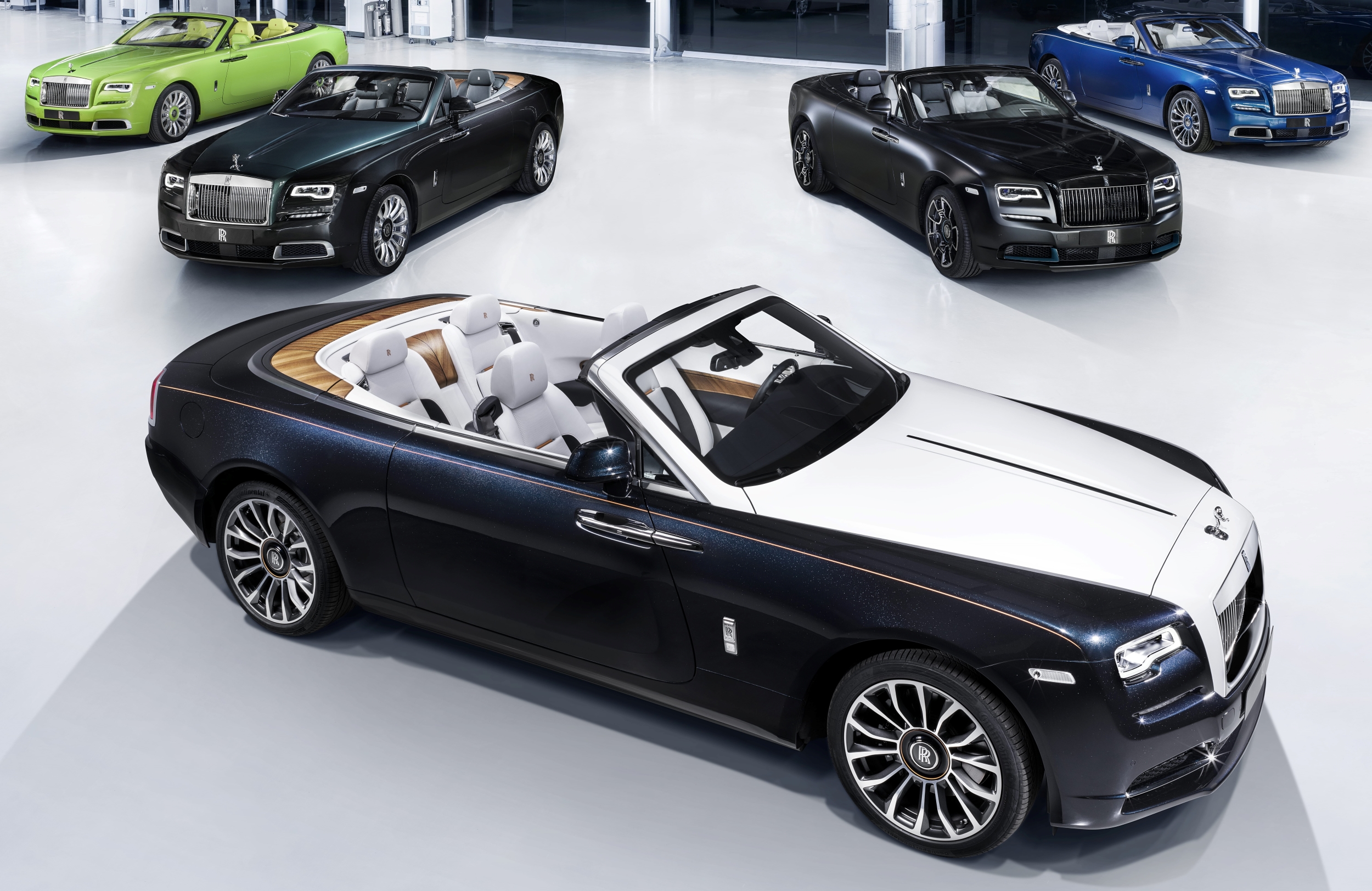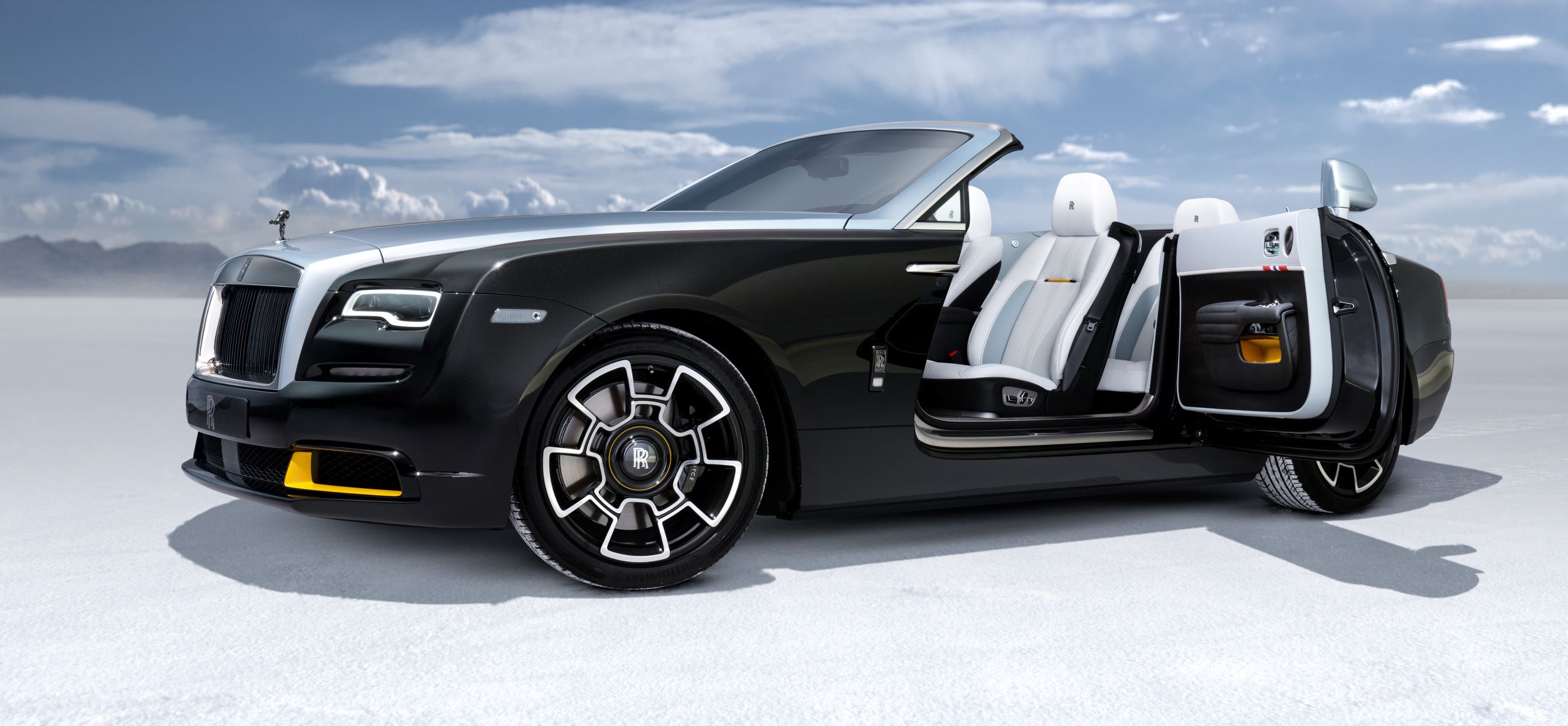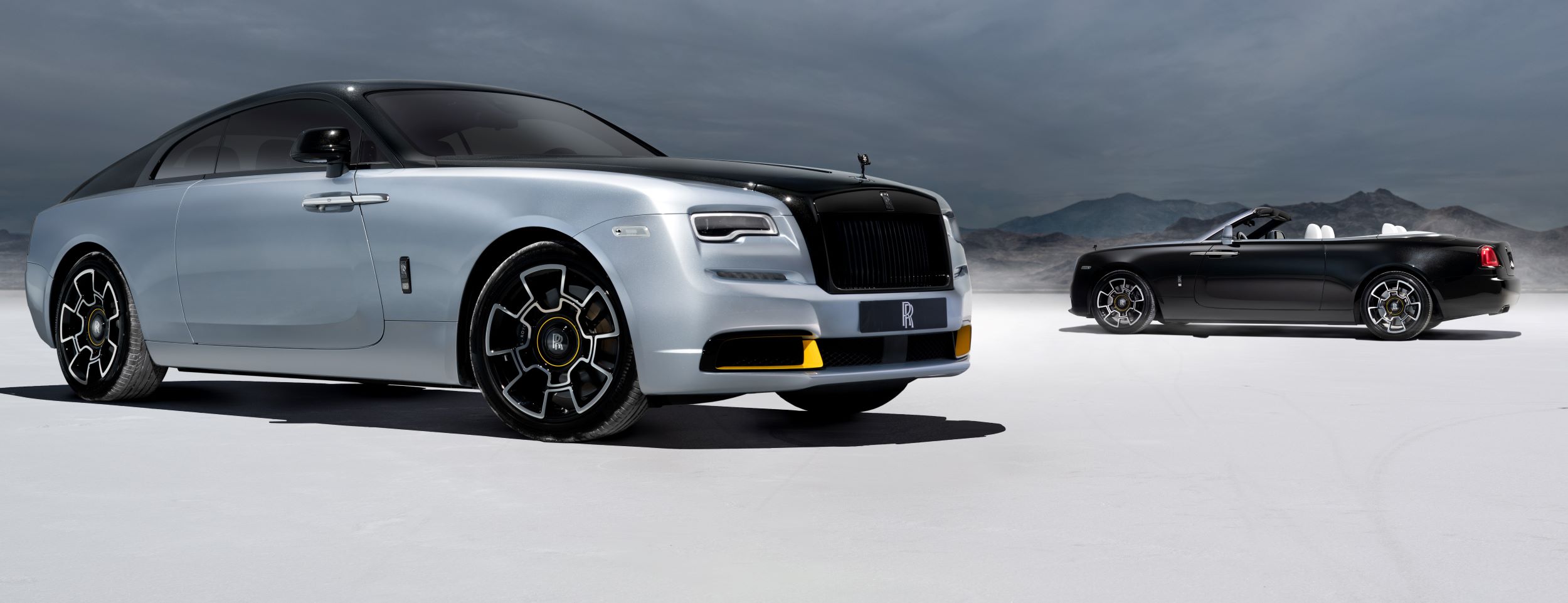
FAREWELL TO DAWN. THE VERY LAST DAWN TO BE PRODUCED AT THE HOME OF ROLLS-ROYCE, GOODWOOD.
Torsten Müller-Ötvös, Chief Executive Officer, Rolls-Royce Motor Cars statement “In reviving the Dawn nameplate, Rolls-Royce reinvigorated something much more than a motor car – like the glamorous convertible it drew inspiration from, the contemporary Dawn has come to characterise a modern expression of ‘la dolce vita’; a way of living that embraces the beauty and richness of life. Dawn truly reflects the joy of good company, the thrill of adventure and the peace of quiet reflection. Indeed, this motor car is a testament to the modern art of living, recalling ‘la dolce vita’ spirit in every detail. As production of Dawn draws to a close, we can reflect on an extraordinary chapter in the marque’s history. This beautiful motor car perfectly embodies contemporary luxury while celebrating the marque’s founding principles and heritage.”
Rolls-Royce Motor Cars signals the end of a glorious, glamorous era as it ceases production of its Dawn convertible. In this retrospective, the marque reflects on the best-selling drophead in the brand’s history as it takes its own unique place in the pantheon of great Rolls-Royce motor cars.
CONTEMPORARY GLAMOUR AND ROMANCE
Following the success of Phantom VII, and its stablemates Phantom Coupé and Phantom Drophead Coupé, an increasingly youthful, universally self-confident and sociable client base was drawn to the Rolls-Royce brand. These new super-luxury consumers required a motor car that, like the first transformative models of Rolls-Royce’s Goodwood era, captured the glamour and romance of super-luxury motoring; but did so in a fashion completely in tune with their contemporary tastes and lifestyles.
Rolls-Royce CEO, Torsten Müller-Ötvös, recognised that there was space in the marque’s product portfolio to fulfil these clients’ desires. Accordingly, he challenged his designers to create not just a stablemate to Phantom Drophead Coupé, but an entirely new kind of super-luxury convertible. More than simply a beautiful motor car, it should evoke the romance and glamour that informs so much of Rolls-Royce’s legend, while offering a social, approachable and contemporary expression of open-top touring to an ascendant new generation.
Furthermore, it had to be completely new. Three years earlier, Rolls-Royce had launched its fastback coupé Wraith; but the idea of repurposing it was never considered. Instead, the marque’s designers found inspiration much earlier in the company’s vast and storied history. Between 1950 and 1954, Rolls-Royce made just 28 examples of the Silver Dawn drophead coupé. The Dawn nameplate, with its connotations of new beginnings, fresh opportunities and glorious vistas, was unanimously approved as the perfect candidate for a 21st Century reincarnation.
The seductively elegant original perfectly embodied the spirit of its age, immortalised in the expression ‘la dolce vita’ – ‘the sweet life’. A reminder to savour every moment and live fully in the present, ‘la dolce vita’ came to signify good company and quiet reflection – the importance of taking time to dwell on the pleasures of life in all its beauty and richness.
Most famously, La Dolce Vita was also the title of the classic 1960 film directed by Federico Fellini. Now widely regarded as one of the greatest films ever made, it made a global star of actress Anita Eckberg, and the Trevi Fountain, until today one of Rome’s most visited tourist attractions. Naturally, it also featured on mood boards within the Rolls-Royce design studio.
EXQUISITE ELEGANCE PAIRED WITH LUXURIOUS COMFORT
In the context of the film, ‘la dolce vita’ was a life filled with passion, adventure and romance. It was sensuous and sensual, a celebration of decadence, indulgence and pleasure in all its forms. It was this spirit that Rolls-Royce wanted to capture in its new drophead, expressed through timeless form language, contemporary craft and an effortless yet potent dynamic character.
The boldness of that vision was reflected in Dawn’s design. Its pure, simple form was inspired by fifties and sixties fashion, which evoked glamour by removing superfluous lines and textures, focussing instead on how it amplified the form of the wearer. Similarly, Dawn’s supple, flowing coachwork wraps around its occupants akin to raising a collar on an overcoat, affording those inside a cossetting, private and chic cabin experience.
Indeed, in creating Dawn, 80% of the panels were entirely unique, including a ‘wake channel’ on the bonnet emanating from the Spirit of Ecstasy, evoking the sensation of quietly gathering energy while provisioning drivers with a permanent vanishing point – a design feature that endures on Rolls-Royce motor cars today.
However, in one vital respect, Dawn broke with a long-established automotive design convention. Almost without exception, convertibles are designed in a 2+2 configuration, with full-size seating for the driver and one passenger in the front, plus two smaller seats for occasional passengers or children in the rear. The lack of rear-seat space, and particularly legroom, reduces the car’s comfort and practicality – a shortcoming Rolls-Royce refused to accept. Dawn was therefore a full four-seater with comfortable, individual seating for all occupants.
The very simplicity of Dawn’s design belied a host of complex engineering challenges, most notably the intricate roof mechanism, dubbed the ‘Silent Ballet’ for its precision, elegance and noiseless operation. A convertible hardtop had been briefly considered, however the marque’s designers decided Dawn’s roof should be created from fabric to retain the romance of listening to raindrops on canvas. Instead, a unique blend of materials, including fabric, cashmere and high-performance acoustic composites, made Dawn the world’s quietest convertible: with its roof closed, Dawn equalled the Rolls-Royce Wraith for noise-isolating performance.
A MODEL TESTING PROGRAMME
In quintessential Rolls-Royce style, engineers spent months optimising the convertible experience with an exhaustive testing programme – neither eliminating airflow completely nor permitting disruptive levels into the cabin. To achieve this, the test subject was a modified mannequin provisioned with a wig of long, flowing hair. It was chauffeured for hundreds of hours while a bank of sensors and cameras faithfully recorded how the hair was displaced by the moving air. The resulting data enabled engineers to make Dawn the world leader in aerodynamic comfort with the roof open.
Rolls-Royce also recognised the centrality of the driving experience for many of the younger clients Dawn was created for. Thus, beneath its svelte, minimal lines, Dawn received the marque’s near-silent 6.6-litre, 563bhp twin-turbo V12 engine. The chassis, naturally, delivered the brand’s signature ‘Magic Carpet Ride’, combining responsiveness and engagement with an almost supernatural smoothness.
Indeed, during a product experience later in Dawn’s life, an American journalist passed through an area as it was struck by an earthquake measuring 3.6 on the Richter scale, followed by a 2.7 aftershock; such was the smoothness of the ride, he learned of this only when he read about it in the press the following morning.
BLACK BADGE DAWN
In 2017, Rolls-Royce added a Black Badge variant of Dawn to its model family. Like the Ghost and Wraith that preceded it, Dawn’s alter ego derived its character from a series of engineering and design treatments. An entirely new exhaust system added a bass baritone quality to the engine note; the engine itself was tuned to deliver an extra 30bhp and boost torque to 840Nm. While appealing to the rebel spirit that attracts so many to this noire expression of the brand, Black Badge Dawn created its own singular place in the Rolls-Royce Pantheon – one characterised by the romance and seduction of the city at night.
A LASTING LEGACY
Beyond its desirability, Dawn brought the spirit of ‘la dolce vita’ to Rolls-Royce’s contemporary brand promise through an exquisite marriage of seductive design, contemporary materials, and a social, open-air driving experience. In doing so, Dawn has ensured its legacy by compelling an entirely new generation to the marque.
CO2 EMISSIONS & CONSUMPTION.
- Rolls-Royce Dawn: NEDC (combined): CO2 emission: 372-367 g/km; Fuel consumption: 17.3-17.5 mpg / 16.3-16.1 l/100km. WLTP (combined): CO2 emission: 381-367 g/km; Fuel consumption: 16.9-16.2 mpg / 16.7-17.4 l/100km.
- Black Badge Dawn: NEDC (combined) CO2 emission: 371 g/km; Fuel consumption: 17.3 mpg / 16.3 l/100km. WLTP (combined) CO2 emission: 382-380 g/km; Fuel consumption: 16.7-16.9 mpg / 16.9-16.8 l/100km

ROLLS-ROYCE LANDSPEED COLLECTION: RECALLING A FORGOTTEN HERO
- Rolls-Royce Collection of Wraith and Dawn Black Badge
- Landspeed Collection celebrates the records set by British engineer Captain George Eyston in Thunderbolt, powered by two Rolls-Royce R V12 aero engines
- Interior details recall the Bonneville Salt Flats in Utah, where Eyston pursued his record-breaking endeavours in 1937-38
- Salt Flats’ fissured texture is perfectly reproduced in the engraved fascia; steering-wheel detail mimics the dark track-line marked on the surface during record runs
- Starlight Headliner precisely depicts the night sky on 16 September 1938, when Eyston set his third and final land-speed record of 357.497 mph
- Silhouettes of the long-lost Thunderbolt, and its three record-breaking speeds, are laser-engraved on the front tunnel
- Subtle detail in driver’s-side door reproduces ribbon colours of the honours awarded to Eyston during his lifetime
- Production limited to just 35 examples of Wraith Black Badge, and 25 of Dawn Black Badge
Rolls-Royce has been associated with world speed records on both land and water for more than a century. But while the exploits of Sir Malcolm Campbell are well documented and widely known, another British hero who set three land-speed records using Rolls-Royce engines has been largely overlooked by history.
Now, after more than 80 years, Rolls-Royce recalls this hero’s inspiring exploits. With the new Wraith and Dawn Black Badge Landspeed Collection, the marque uncovers and retells the remarkable story of the redoubtable Captain George Eyston, and his extraordinary car, Thunderbolt.
Born in 1897, George Eyston was fascinated with motorsport from childhood, racing both cars and (under an assumed name) motorcycles while still at school. His degree in engineering at Trinity College, Cambridge, was interrupted by the Great War, in which he served with distinction, rising to the rank of captain and winning the Military Cross. He spent the 1920s and 30s developing and driving racing cars; a talented inventor, he also held a number of patents, particularly in the field of supercharging.
In 1935, Eyston was among the first British racers to travel to the Bonneville Salt Flats in Utah, where he set new 24-hour and 48-hour endurance speed records. He subsequently received the Segrave Trophy, awarded to ‘the British national who demonstrates Outstanding Skill, Courage and Initiative on Land, Water and in the Air’.
In 1937, he returned to the Flats and went on to set three world land-speed records with Thunderbolt. This extraordinary machine had three axles, eight wheels and weighed seven tonnes, earning it monikers such as ‘behemoth’ and ‘leviathan’ in contemporary reports. The body was made from aluminium and, in its original form, had a blunt, heavyset profile topped with a large triangular tailfin.
CELEBRATING ACHIEVEMENT, INNOVATION AND COURAGE
The Rolls-Royce Landspeed Collection draws inspiration from George Eyston’s remarkable life and record-breaking feats. It also has strong aesthetic links to the unique, otherworldly landscape of the Bonneville Salt Flats where Thunderbolt made him, albeit briefly, the fastest man on Earth. The Collection Car duo is presented in a specially created two-tone finish, which marries Black Diamond Metallic with a new Bespoke colour, Bonneville Blue. This specially developed hue bears particular significance to the Collection, with a colour that transitions under sunlight from light blue to silver, illustrating the reflections of both the vast sky over Bonneville and the crisp salt flats on Thunderbolt’s aluminium body.
Thunderbolt was powered by a pair of Rolls-Royce R supercharged 37-litre, V-12 aero engines, each producing well over 2,000 horsepower. Around only 19 of these engines were ever made: indeed, they were so rare that Thunderbolt’s engines had a previous career in the Schneider Trophy-winning Supermarine S6.B seaplane that would lay the foundations for the legendary Spitfire.
Today, Thunderbolt’s two R engines are preserved at the Royal Air Force Museum, Hendon and the Science Museum in London. The car itself, however, has been lost. After being exhibited at the 1940 Centennial Exhibition in New Zealand, it was placed in storage, but was sadly destroyed in 1946 when 27,000 bales of wool, housed in the same building, caught fire.
HOLDING THE LINE
Eyston set his records on the International Speedway, a specially compacted section of the Bonneville Salt Flats 10 miles (16km) long and 80 feet (24m) wide. The terrain is perfectly level in all directions and shines brilliant white in the sunlight: the absence of landmarks and ferocious glare combines to make holding course and judging distance extremely difficult at high speed.
George Eyston himself, commented, “On the salt bed, which has to be carefully prepared by dragging, we paint one or more black lines along the whole length. These lines act as guides and prevent the driver straying; for errors of a few feet in steering might culminate in disastrous results. You see, you might drive a few feet away from the absolute line, something else might happen and you get a few feet more and, believe me, you will never get back”.
As he recognised, deviating from the speedway would have been extremely hazardous, particularly given Thunderbolt’s enormous weight. In response, Eyston’s team painted darkened track lines on the salt surface for Eyston to follow – effectively his sole means of keeping Thunderbolt straight at over 350 mph.
This simple yet ingenious idea is recalled in the Landspeed Collection by a subtly perforated dark detail in the upper-centre of the steering wheel, which continues through the centre-line of the driver’s seat, accentuating both Wraith and Dawn’s driver focused appeal.
The Bonneville Salt Flats may appear smooth; but in fact, they’re seamed with tiny fissures. This distinctive texture is perfectly reproduced, digitally retraced from the surface itself, in the wooden veneer of Landspeed Collection’s fascia and console lids. The interior references continue with Thunderbolt’s unique silhouette, and the records it achieved, depicted on the polished, anodised aluminium surface of the Landspeed Collection’s front tunnel. Dawn Landspeed additionally celebrates George Eyston’s vision with the outline of the Silver Island mountains, which dominate the Bonneville horizon, engraved on the upper ‘waterfall’ between the rear seats.
According to the history books, Eyston’s third and final land-speed record of 357.497 mph stood for 341 days. In the new Collection Cars, it is commemorated for all time, engraved into the housing of the dashboard clock alongside the name ‘Bonneville’, in homage to where the record was set.
Thunderbolt was originally left unpainted, which caused an unexpected problem. During the first record attempts, the photo-electric timing equipment was unable to detect the polished aluminium body against the searing white of the Salt Flats’ surface, making accurate timing impossible. Eyston’s brilliantly simple solution was to paint a large black arrow with a yellow circle on the side, to heighten visibility when travelling at great speed. Bright yellow accents throughout the Landspeed Collection, including two-tone yellow and black bumper inserts, pay tribute to this vision.
The clock’s design recounts this theme. Based on the instrument dials from Thunderbolt, with yellow and black details, black-tipped hands are inspired by the arrows painted on the original car’s exterior.
The allure of the Bonneville Salt Flats draws not only record-breakers, but astronomers, too. Stargazers prize this vast, unpopulated wilderness for its exceptionally dark night skies, which create perfect conditions unspoiled by artificial light.
In Wraith Landspeed, the Starlight Headliner perfectly recreates the heavens as they appeared over the Flats on 16 September 1938, the date on which Eyston and Thunderbolt set their third and final world land-speed record. The constellations are precisely marked using 2,117 individually placed fibre-optic ‘stars’, the largest number of stars in a Rolls-Royce Wraith Starlight Headliner ever featured.
During his lifetime, George Eyston received three significant honours. He was awarded the Military Cross (MC) while serving in the Great War; in 1938, after his record-breaking runs with Thunderbolt he was made a Chevalier of the Légion d’honneur, France’s highest civilian decoration; and in 1948, he received the Order of the British Empire (OBE).
These honours are marked in both Wraith and Dawn Landspeed with a subtle detail in the driver’s door, made in the same Grosgrain weave silk and colours to match the original medal ribbons. The armrests on both the passenger side and below the ribbon detail are specially padded to give them the comfortable ‘club armchair’ quality that Eyston favoured in his driving seats, much to the amusement of his fellow racers.
Production of Landspeed Collection cars is strictly limited to just 25 examples of Dawn and 35 of Wraith, all of which have already been allocated to customers.
In closing, Mr Müller-Ötvös said, “Rolls-Royce has been synonymous with adventure, daring and pushing boundaries throughout its history. We are delighted that with the Landspeed Collection, we can add another hitherto unsung hero to the illustrious roll call of pioneers associated with our great marque. With his vision, boldness, determination and genius for innovation and invention, George Eyston embodies so much of what makes Rolls-Royce unique. These cars are a fitting and long overdue tribute to a truly inspiring character.”


You must be logged in to post a comment.